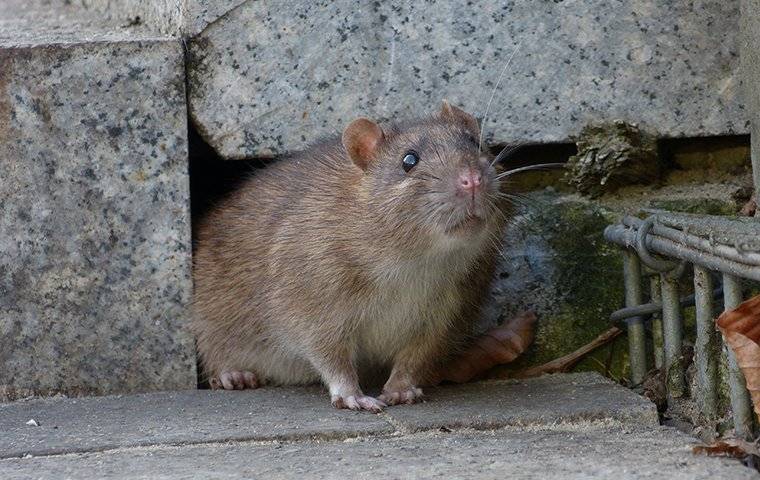
Are You Dealing With A Rat Infestation Inside Your Richmond Residence?
Rats are miserable pests to deal with in your home. They damage your stuff, damage your home, and make you sick. The first step in dealing with rats is determining that you have a rat infestation. Today, we'll tell you how to detect rats in Richmond, share what causes rat infestations, and offer six prevention tips to drive rats out of your residence. Stick with us to the end and we'll share with you how Richmond pest control deals with city rats. You're sure to find some great ideas here!

Do I Have A Rat Infestation?
Rats are big rodents, but they can move about in your home as quiet as a mouse. You'll need to perform an inspection to figure out if you have a rat infestation. Here's how you can look for signs of rats in your Richmond home.
Droppings: All rodents leave droppings as they explore. They also leave waste in their nests. It's pretty gross, but as gross as droppings are, they can help you detect rats in your home. Look for droppings in the cabinet under your kitchen sink, around and under appliances, behind objects on the floor in your pantry, and in your attic spaces.
Urine: Rodents don't just leave feces as they explore; they leave little droplets of urine. Some say they do this to mark their territory, but this is not the case. The primary reason rats leave urine around is so they can navigate with their noses. Rats create a map of their environment based on touch response, smells, and sounds, which is why they can move about in utter darkness.
Grease: The fur of a rodent is greasy. As rats run along baseboards, wood timbers, and other structural materials, they leave a stain. Look for these stains down low and along walls in your home. If you inspect your attic, look for grease marks on rafters and trusses.
Holes: Rats make holes in many things. You can use those holes to see where rats are active in your home. Look underneath cabinet overhangs in your kitchen, inspect walls behind appliances, and make sure to check your pantry thoroughly. A rat only needs a quarter-sized hole. Keep this in mind as you inspect.
Detection is critical before, during, and after applying rodent control. You can use detection to tell where rodents are active, what routes they're using, and roughly the size of the population.
What Causes A Rat Infestation?
It is essential to understand how rats get into your home if you hope to keep them from getting in or to prevent them from entering in the first place. You need to understand what attracts rats and how they get inside. Here are a few examples to help you understand rats better.
- The scent of a trash receptacle can attract rats from a distance. Rats have a powerful sense of smell. If you can smell your trash, they will definitely smell it. Make sure to get your receptacles to the curb weekly. If you fail to do this, wash your receptacles to remove rat-attracting odors.
- Rats eat birdseed. If you hang bird feeders up, you'll do more than attract birds. Rats love seeds. They'll eat them off the ground and also climb up to the feeders to get at the seeds.
- Rats eat nuts and fruit. Do you have trees that produce nuts? Do you have trees or bushes with fruit? These food sources are highly sought after by rats, mice, and squirrels.
- Rats love cluttered yards. They have poor eyesight and need clutter on the ground to help them pass through large, open areas, like lawns. They'll use toys, tools, stacked wood, leaves, and other ground clutter.
- Dense vegetation provides a hiding place. Trim areas of your landscaping that provide cover for rats and particularly the base of plants.
- Rats get into the voids underneath decks, patios, exterior stairs, and sheds. They'll also get into your crawlspace if you have one. Use hardware cloth to block access to voids. When you install the hardware cloth, insert it at least a foot into the ground. Doing this will prevent rats from tunneling underneath.
- Available entry points in your exterior. Every gap, crack, and hole in your exterior is a potential entry point for rats. Closely examine your foundation and exterior. Seal any openings you find, no matter how small. Rats turn small holes into large holes. Also, replace building materials such as weatherstripping, door sweeps, screens, etc.
- Pathways to get to your roof. Rats are incredible climbers. They can use tree branches to jump onto your roof, so trim them away from your roofline. They can use pipes to scale the sides of your home, install guards to prevent this. They can work their way up through your downspouts. Insert wire mesh into your downspouts to keep rats out.
Remove attractants to reduce rat activity on your property. It isn't easy to do, but it is well worth the effort because you'll do more than control rats. Removing these attractants may reduce mice, squirrels, other wildlife, ticks and fleas, insects, and bugs.
Here Are Six Tips For Dealing With A Rat Infestation
If you perform an inspection and discover rats, the next step is to determine what you're going to do about them. We've already provided some insight into what you'll need to do to prevent rats from continuing to get into your home. But that is not step one.
1. Remove Indoor Food Options
While rats can live in your home for no other reason than to have protection from outdoor predators, they prefer homes with food; this is particularly true for roof rats. Remove food options and you could remove the rats. The primary ways to remove indoor food options is to clean, deep clean, and store food in sealed containers. Inspect your entire home and consider all the ways a rat might get a bite to eat.
2. Remove Indoor Water Sources
Water is essential for all life. The rats in your home could leave if they are dependent on an indoor moisture source. Repair plumbing issues and consider water sources such as your pet's water dish. Rats are nocturnal, so pick water dishes up before nightfall.
3. Clean Cluttered Spaces
Rats prefer to move about in spaces that have objects resting on the ground. They use their whiskers like a blind man uses a cane. Clean up finished attic spaces and storage rooms and remove debris from unfinished attic spaces to deter rats. Be cautious if you find rats moving around in these spaces. While it is uncommon to have rats attacking humans, they can and do bite if they feel threatened.
4. Apply Exclusion Work
Once rats have had time to leave your home, you can set your attention on sealing entry points in your exterior and removing the routes that rats are taking to get into your home. The tools for this job are expanding foam, caulking material, wire mesh, hardware cloth, and mortar. We talked about this above. You'll need to seal every opening and you'll also need to replace damaged protective building materials such as weatherstripping, door sweeps, screens, weep hole protectors, vent covers, etc.
5. Remove Exterior Attractants
The more rats you have near your home, the more trouble you'll have with rats inside your home. After you've sealed entry points, address the attractants we talked about earlier. You want to reduce rat activity near your home so fewer rats are looking for entry points you may have missed.
These five steps are often all that is needed to control rats, as long as there aren't conducive conditions that are difficult to address. If the rats don't leave, or you run into some trouble, contact Go-Forth Home Services for assistance.
What Does Go-Forth Home Services Do About Rats In My Home?
It is a lot of work to control rats, and removing rats from your Richmond home is work best left to a licensed technician. If you decide to get professional assistance, go with a pest control service provider that offers exclusion work. Not all do. Exclusion work, as we discussed above, is critical if you hope to keep rodents from getting into your home. Also, keep in mind that you'll have to tackle some exclusions yourself, such as sealing potential entry points on your roof, repairing rotted wood, or replacing weatherstripping. Your Go-Forth Home Services technician can point out potential vulnerabilities and address ground-level exclusion work for you. Since rodents typically get in by way of ground-level entry points, we provide the most important protection you'll need for your home. Along with exclusions, your technician will inspect your home, develop a control strategy, and systematically work to remove all the rats in your home. We use the most trusted rat control products and deploy them according to strict protocols. When we're done, you won't have to wonder if you still have rats.
Are you ready to start living a rat-free life? Give us a call or drop us a line on our contact page. We look forward to helping you solve your rat problems.
Customer Reviews
-
“He spent time educating us about "pests" and provided information regarding services with GoForth.”- Joyce C.
-
“Texted me before coming. Worked with me playing musical rooms with my dogs. I'll see how things are.”- Constance E.
-
“Amazing response time, reasonable prices, great customer service. Tevin was thorough and confident in his plan to fix our horrendous fire ant problem. We have had negative experiences with prior exterminators and probably waited way too long to call Go-For”- Ashley T.
-
“- Toya B.
We have been customers for almost 7 years for a reason. Our technician is the best. He always knows exactly how to address whatever pest has decided to bother us. We have referred them to many of our neighbors. Well worth the cost not to have to worry a
” -
“Answered all my questions and I felt their pricing was very reasonable.”- Deborah J.
-
“Brian went above and beyond what was expected, and I hope I get him again as my technician for future services!”- Tam L.
-
“He was thorough with inspecting and treating our home, which I really appreciate, and he took the time to answer my many questions.”- Jasmine B.
-
“Love the detailed summary and pics of what he did and saw! And did I mention how wonderful Olivia was to get us all set up?!!”- Beechy A.


Over the years, we’ve boiled down our mission to a core set of values:
-
Give A CrapDelight others by owning your role and saying yes. Take pride in how you appear & act & every other detail of the job. Be on time, attentive, & enthusiastic. Act as if the buck stops with you on every aspect of the job.
-
Chase PerfectionChase Perfection, knowing full well we will not reach it, but along the way we will catch excellence. Have a sense of urgency; Go-Forth Time - right now might be the only time you have to get it right.
-
Dig Deeper
Be an action-oriented professional that makes decisions based on evidence rather than stories & assumptions. Stay curious. Data can speak for itself.
Understand the cause of the fire rather than rushing to extinguish it.
-
Fight For SimplicityKeep it simple & consistent. Focus on how things should be done every time.
-
Face It, Fix ItConfront challenges directly and address issues head-on. A bias for action and powerful conversations drive our progress. It’s about getting it right rather than being right.
-
Grow!Growth is our purpose. Growing as people & growing our business.